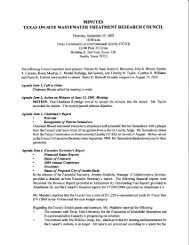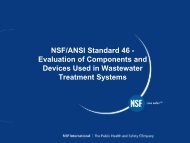flow equalization for controling flow through an ossf - Texas Onsite ...
flow equalization for controling flow through an ossf - Texas Onsite ...
flow equalization for controling flow through an ossf - Texas Onsite ...
Create successful ePaper yourself
Turn your PDF publications into a flip-book with our unique Google optimized e-Paper software.
FLOW EQUALIZATION<br />
FOR CONTROLING FLOW<br />
THROUGH AN OSSF<br />
Bruce Lesikar<br />
<strong>Texas</strong> AgriLife Extension Service
What we will learn<br />
Defining wastewater <strong>flow</strong> from a facility<br />
Variability in <strong>flow</strong><br />
What is <strong>flow</strong> m<strong>an</strong>agement<br />
Evaluating <strong>flow</strong> <strong>for</strong> design<br />
Choosing the right size t<strong>an</strong>k<br />
M<strong>an</strong>aging <strong>flow</strong>s greater th<strong>an</strong> system<br />
capacity<br />
Flow <strong>equalization</strong> t<strong>an</strong>k components
Wastewater loading<br />
Two Q’sQ<br />
Wastewater qu<strong>an</strong>tity<br />
Hydraulic loading<br />
Residential 120-150<br />
150<br />
gallons per bedroom<br />
Wastewater quality<br />
Org<strong>an</strong>ic loading<br />
Residential < 300<br />
mg/L BOD 5<br />
Oxygen dem<strong>an</strong>d<br />
Residential <strong>an</strong>d<br />
commercial facilities
Residential Wastewater Usage<br />
<strong>Texas</strong> 30 TAC Chapter 285<br />
Type of Facility<br />
Usage Rate,<br />
Gallons/Day<br />
(without<br />
water saving<br />
devices)<br />
Usage Rate,<br />
Gallons/Day<br />
(with water<br />
saving<br />
devices)<br />
Single family dwelling (one or two bedrooms) - less th<strong>an</strong> 1,500 square<br />
feet.<br />
225 180<br />
Single family dwelling (three bedrooms) - less th<strong>an</strong> 2,500 square feet. 300 240<br />
Single family dwelling (four bedrooms) - less th<strong>an</strong> 3,500 square feet. 375 300<br />
Single family dwelling (five bedrooms) - less th<strong>an</strong> 4,500 square feet. 450 360<br />
Single family dwelling (six bedrooms) - less th<strong>an</strong> 5,500 square feet. 525 420<br />
Greater th<strong>an</strong> 5,500 square feet, each additional 1,500 square feet or<br />
increment thereof.<br />
75 60
Aerobic Treatment Unit Sizing<br />
<strong>for</strong> Residences<br />
Number of Bedrooms /Living area<br />
Minimum Aerobic<br />
Treatment Capacity<br />
(gal per day)<br />
Traditional sizing of<br />
Aerobic Treatment<br />
Capacity (gal per day)<br />
One or Two bedroom, less th<strong>an</strong> 1501 ft 2 400 450<br />
Three bedroom, less th<strong>an</strong> 2501 ft 2 400 600<br />
Four bedroom, less th<strong>an</strong> 3501 ft 2 480 750<br />
Five bedroom, less th<strong>an</strong> 4501 ft 2 600 900<br />
Six bedroom, less th<strong>an</strong> 5501 ft 2 720 1050<br />
Seven bedroom, less th<strong>an</strong> 7001 ft 2 840 1200<br />
Eight bedroom, less th<strong>an</strong> 8501 ft 2 960 1350<br />
Nine bedroom, less th<strong>an</strong> 10,001 ft 2 1,080 1500<br />
Ten bedroom, less th<strong>an</strong> 11,501 ft 2 1,200 1650<br />
For each additional bedroom above ten or 120 150<br />
1,500 ft 2 of living area above 11,500 ft 2
Estimating Hydraulic Loading<br />
Number of bedrooms<br />
Square footage of a<br />
facility<br />
Water conserving<br />
devices<br />
Special fixtures<br />
<br />
<br />
Multi-head showers<br />
Oversized / garden tubs
Total daily <strong>flow</strong><br />
Distribution of me<strong>an</strong> household daily per capita indoor water use <strong>for</strong> 1,188 data-logged<br />
homes (EPA 2002: <strong>Onsite</strong> Wastewater Treatment System M<strong>an</strong>ual)<br />
18%<br />
16%<br />
14%<br />
12%<br />
Relative Frequency<br />
10%<br />
8%<br />
6%<br />
4%<br />
2%<br />
0%<br />
0<br />
10<br />
20<br />
30<br />
40<br />
50<br />
60<br />
70<br />
80<br />
90<br />
100<br />
110<br />
120<br />
130<br />
140<br />
150<br />
160<br />
170<br />
180<br />
190<br />
200<br />
More<br />
Me<strong>an</strong> Indoor Gallons Per Capita Per Day
Wastewater qu<strong>an</strong>tity<br />
Residential<br />
Commercial<br />
Design<br />
Daily <strong>flow</strong><br />
Average<br />
Peak - high <strong>flow</strong><br />
Surge – disrupts<br />
system<br />
Seasonal<br />
Define the <strong>flow</strong>
Wastewater qu<strong>an</strong>tity - peaks<br />
Peak <strong>flow</strong>s<br />
<br />
<br />
<br />
Daily - runoff period<br />
Weekly<br />
Seasonal
Inst<strong>an</strong>t<strong>an</strong>eous <strong>flow</strong><br />
Use large volumes of<br />
water in short time -<br />
gpm<br />
Add hydraulic surges<br />
that disrupt treatment<br />
processes<br />
Get in<strong>for</strong>mation on<br />
water using devices:<br />
How much water is<br />
used<br />
How often it is used
Variation in <strong>flow</strong>
Flow <strong>an</strong>d treatment components<br />
All components have a maximum <strong>flow</strong> rate<br />
<br />
Design <strong>flow</strong> – maximum <strong>flow</strong> rate<br />
• Daily (gpd), Hourly (gph)<br />
Best per<strong>for</strong>m<strong>an</strong>ce<br />
<br />
<br />
Average daily <strong>flow</strong> < 70% of design capacity<br />
Flow <strong>equalization</strong> facilitates loading close to design<br />
Greater attention/monitoring needed<br />
<br />
Average daily <strong>flow</strong> > 70% of design capacity<br />
• Peak <strong>flow</strong>s are near or greater th<strong>an</strong> the design capacity<br />
Frequency may be set by regulatory agency,<br />
m<strong>an</strong>ufacturer, or designer
Flow rate <strong>for</strong> treatment<br />
Total daily <strong>flow</strong><br />
System capacity<br />
Gallons per day<br />
500, 600, 750, 1000,<br />
1250, 1500 gpd<br />
Hourly <strong>flow</strong>s<br />
<br />
<br />
Volume per hour<br />
60, 90, 120 gph<br />
Inst<strong>an</strong>t<strong>an</strong>eous <strong>flow</strong><br />
<br />
<br />
Volume per minute<br />
1, 1.1, 2 gpm<br />
components
Flow m<strong>an</strong>agement<br />
How c<strong>an</strong> <strong>flow</strong> from a facility be m<strong>an</strong>aged?<br />
<br />
<br />
<br />
Education of owner<br />
• Ch<strong>an</strong>ge water use habits to match system capacity<br />
• <strong>Onsite</strong> wastewater treatment system defines<br />
owners lifestyle<br />
Moderation within system<br />
• T<strong>an</strong>k surface area to distribute volume <strong>an</strong>d reduce<br />
velocity – Greater treatment capability<br />
• Q = V x A; gallons per inch<br />
Flow <strong>equalization</strong><br />
• Surge or <strong>flow</strong> <strong>equalization</strong> t<strong>an</strong>k with timed dosing
Flow <strong>equalization</strong>/surge t<strong>an</strong>k<br />
Moderates <strong>flow</strong> from<br />
facility<br />
Sized based on peak<br />
to be moderated<br />
<br />
<br />
<br />
Inst<strong>an</strong>t<strong>an</strong>eous<br />
Daily<br />
Weekly<br />
Improves treatment<br />
by downstream<br />
components
M<strong>an</strong>aging hydraulic loads<br />
Need to determine the length, timing <strong>an</strong>d<br />
volume of peak <strong>flow</strong>.<br />
<br />
<br />
Residential - typically diurnal pattern<br />
Restaur<strong>an</strong>ts - typically about 2 hours after<br />
lunch <strong>an</strong>d dinner.<br />
• Food preparation <strong>an</strong>d cle<strong>an</strong>-up time<br />
Variability in actual water use may not<br />
match “typical” or expected peak <strong>flow</strong><br />
pattern.
Do not rely on published<br />
design criteria when<br />
repairing <strong>an</strong> existing system
Wastewater <strong>flow</strong> characteristics<br />
Type of Facility<br />
Flow*<br />
(gal/cap/day)<br />
lbs. BOD 5<br />
†<br />
(cap/day)<br />
Runoff<br />
(hours)<br />
Shock<br />
Load<br />
Factor<br />
Airports - per passenger 5 .020 16 low<br />
Airports - per employee 15 .050 16 low<br />
Apartments - multiple family 75 .175 16 medium<br />
Boarding Houses 50 .140 16 medium<br />
Bowling Alleys - per l<strong>an</strong>e (no food) 75 .150 8 medium<br />
Campgrounds - per tent or travel trailer site - central<br />
bathhouse<br />
50 .130 16 medium<br />
Camps - construction (semi-perm<strong>an</strong>ent) 50 .140 16 medium<br />
Camps - day (no meals served) 15 .031 16 medium<br />
Camps - luxury 100 .208 16 medium<br />
Camps - resort - night <strong>an</strong>d day, with limited<br />
plumbing<br />
50 .140 16 medium<br />
Churches - per seat 5 .020 4 high<br />
Clubs - country (per resident member) 100 .208 16 medium<br />
Clubs - country (per nonresident member present) 25 .052 16 medium<br />
Courts - tourist or mobile home parks with<br />
individual bath units<br />
50 .140 16 medium<br />
Dwellings - single family 75 .170 16 medium<br />
Goldstein <strong>an</strong>d Moberg, 1973
Data required<br />
Flow characteristics:<br />
<br />
<br />
<br />
Average daily <strong>flow</strong><br />
Peak <strong>flow</strong><br />
•Regular highs<br />
•Weekly<br />
•Monthly<br />
Special occasions<br />
•How often: <strong>an</strong>nually/ bi-<strong>an</strong>nual, monthly?
Cash <strong>flow</strong> <strong>an</strong>d<br />
hydraulic <strong>flow</strong>s<br />
are related
Water use habits<br />
To perm<strong>an</strong>ently reduce <strong>flow</strong>s <strong>an</strong>d peaks,<br />
water use habits must ch<strong>an</strong>ge.<br />
Educate system owners<br />
<br />
M<strong>an</strong>agement may ch<strong>an</strong>ge on a routine basis<br />
Help system owners see the $$$$ benefit<br />
to m<strong>an</strong>aging water use<br />
Need a good working relationship with<br />
owner
Water saving devices<br />
Decreases the <strong>flow</strong><br />
No effect on the<br />
overall org<strong>an</strong>ic load
Flow <strong>equalization</strong> systems<br />
Makes the <strong>flow</strong> introduced to the treatment<br />
system more consistent.<br />
Flow <strong>equalization</strong> is import<strong>an</strong>t if:<br />
<br />
<br />
<br />
The average daily <strong>flow</strong> is ≥ 70% of the design<br />
capacity<br />
Water use habits or facility operations are<br />
variable-<br />
• Example: church only open on Sun.<br />
Frequent peaks exceed system capacity<br />
• Wash day: cle<strong>an</strong>ing service
Effects of <strong>flow</strong> <strong>equalization</strong><br />
Flow variations<br />
% FLow<br />
140<br />
120<br />
100<br />
80<br />
60<br />
40<br />
20<br />
0<br />
1 3 5 7 9 11 13 15 17 19 21 23 25 27 29 31<br />
Days
Other benefits of a <strong>flow</strong><br />
<strong>equalization</strong> system<br />
Monitoring of <strong>flow</strong>s from the surge t<strong>an</strong>k<br />
may help detect<br />
<br />
<br />
<br />
major ch<strong>an</strong>ges in <strong>flow</strong> patterns<br />
leaking effluent<br />
clogging orifices<br />
Provide storage <strong>an</strong>d spread out water<br />
delivery after a power outage.<br />
Regular feeding of the hungry microbial<br />
population which improves treatment.<br />
Regular resting
Flow <strong>equalization</strong> t<strong>an</strong>k
Control p<strong>an</strong>el should:<br />
Track doses<br />
Track time of pump operation<br />
<br />
Flow measurement<br />
Track peak enable-<br />
design <strong>flow</strong><br />
Track pump off events<br />
<br />
Set <strong>flow</strong> too HIGH<br />
Track alarms<br />
<br />
Set <strong>flow</strong> too LOW
Required volumes
Calculating t<strong>an</strong>k volume <strong>for</strong><br />
Measure the <strong>flow</strong><br />
<br />
<br />
commercial systems<br />
Read meter<br />
Calculate <strong>flow</strong><br />
Calculate volume in t<strong>an</strong>k<br />
<br />
Daily <strong>flow</strong> - timed dose<br />
Necessary storage<br />
<br />
<br />
Surge volume<br />
Storage volume [surge<br />
volume + average]<br />
Operating volume<br />
<br />
Storage volume + reserve<br />
volume<br />
T<strong>an</strong>k capacity<br />
<br />
Sum all necessary volumes<br />
[min.+ operating]
Flow controlled by surge t<strong>an</strong>k<br />
Day<br />
Daily <strong>flow</strong><br />
(gal)<br />
Timed dose<br />
(gal)<br />
Sunday pm 700<br />
Monday 250 350 600<br />
Tuesday 200 350 450<br />
Wednesday 150 350 250<br />
Thursday 200 350 100<br />
Friday 250 350 0<br />
Saturday 700 350 350<br />
Sunday 700 350 700<br />
Surge vol.<br />
(gal)
Storage volume<br />
Storage volume = surge vol. + avg.<br />
700 + 350 gpd = 1050 gallons<br />
Storage x peaking = design vol.<br />
<br />
1050 x 1.2 = 1260 gallons
Floats
Why use a peak enable option<br />
in the control p<strong>an</strong>el <strong>for</strong> a <strong>flow</strong><br />
<strong>equalization</strong> t<strong>an</strong>k?<br />
Church example<br />
Design assumptions: Sunday - 2000<br />
gallons, Wednesday – 800 gallons;<br />
average daily <strong>flow</strong> 400 gpd<br />
Actual <strong>flow</strong>: Sunday - 1000 gallons,<br />
Wednesday – 400 gallons
Peak enable option in p<strong>an</strong>el<br />
Day<br />
Daily<br />
<strong>flow</strong><br />
(gal)<br />
Surge vol. -<br />
400 g dose<br />
(gal)<br />
Sunday pm 1000 1000<br />
Monday 600 800<br />
Tuesday 200 600<br />
Wednesday 400 400 800<br />
Thursday 0 600<br />
Friday 0 400<br />
Saturday 0 200<br />
Sunday 1000 1000 1000<br />
Surge vol. -<br />
200 g dose<br />
(gal)
H<strong>an</strong>dling a monthly event<br />
Estimate the size of monthly peak <strong>flow</strong><br />
event relative to expected normal peaks<br />
Increase storage in <strong>flow</strong> <strong>equalization</strong> t<strong>an</strong>k<br />
If the estimated monthly peak was a 30%<br />
increase<br />
Multiply storage volume x 1.3
H<strong>an</strong>dling <strong>an</strong> <strong>an</strong>nual event<br />
Ch<strong>an</strong>ge operating practices<br />
<br />
<br />
<br />
<br />
Single use service<br />
Washing schedule<br />
Pre-cooking<br />
Cle<strong>an</strong>-up<br />
OSSF m<strong>an</strong>agement practices<br />
<br />
<br />
Pump extra capacity from <strong>flow</strong> <strong>equalization</strong><br />
t<strong>an</strong>k<br />
Portable toilets
Flow metering / recording<br />
Eliminates the need <strong>for</strong><br />
guessing hydraulic<br />
loading<br />
A method to collect<br />
accurate <strong>an</strong>d vital <strong>flow</strong><br />
data<br />
Aids when<br />
troubleshooting <strong>an</strong> OSSF<br />
Meter<br />
Cycle counter<br />
Elapsed time meter
Solids h<strong>an</strong>dling<br />
<br />
<br />
Sewage<br />
Effluent<br />
Pump curve<br />
<br />
<br />
Flow<br />
TDH<br />
Robust pump<br />
<br />
<br />
<br />
Pump selection<br />
High cycle rate<br />
Residential grade<br />
Commercial grade
Pump operation<br />
Micro dosing to distribute wastewater over<br />
24 hours, wastewater detention time in<br />
downstream components <strong>for</strong> treatment.<br />
Dose volume:<br />
<br />
<br />
Pump <strong>flow</strong> rate versus run time<br />
Selected based on treatment component <strong>flow</strong><br />
restrictions<br />
Dose volume: m<strong>an</strong>y inst<strong>an</strong>ces volume will<br />
be relatively low (20 to 60 gallons)
What is a timed-dosed dosed system?<br />
Flow controlled by time<br />
Timers<br />
<br />
ON: OFF<br />
Programmable Logic<br />
Controller<br />
<br />
<br />
PLC<br />
Computer
“ON” setting<br />
<br />
Timer settings<br />
Pump ‘on’ time (min) = desired dose (gal) ÷<br />
pump <strong>flow</strong> rate (gal/min)<br />
• 55 gallons per dose<br />
• 55 gal/dose ÷ 44 gpm = 1.25 minutes<br />
• 1.25 min x 60 sec/min = 75 seconds
“OFF” Setting<br />
<br />
<br />
Timer settings<br />
Design <strong>flow</strong> ÷ Gal per dose = # of Doses<br />
• 450 gpd ÷ 55 gal = 8 doses per day<br />
1440 minutes ÷ # of doses - On time = Off time<br />
• 1440 min ÷ 8 doses – 1.25 min. = 178.75 min<br />
• 178.75 min ÷ 60 min/hr = 2.9 hours
Multiple t<strong>an</strong>k construction<br />
Connected at the top <strong>an</strong>d bottom<br />
<br />
<br />
Top connection - air movement<br />
Bottom connection – water movement<br />
Stabilize bottom to prevent settling – concrete<br />
requires special considerations<br />
<br />
Breaking connections with settling<br />
Pump t<strong>an</strong>k lower elevation – full utilization of other<br />
t<strong>an</strong>k <strong>for</strong> <strong>flow</strong>
Summary<br />
Defining wastewater <strong>flow</strong> from a facility<br />
Variability in <strong>flow</strong><br />
What is <strong>flow</strong> m<strong>an</strong>agement<br />
Evaluating <strong>flow</strong> <strong>for</strong> design<br />
Choosing the right size t<strong>an</strong>k<br />
M<strong>an</strong>aging <strong>flow</strong>s greater th<strong>an</strong> system capacity<br />
Components in a p<strong>an</strong>el













